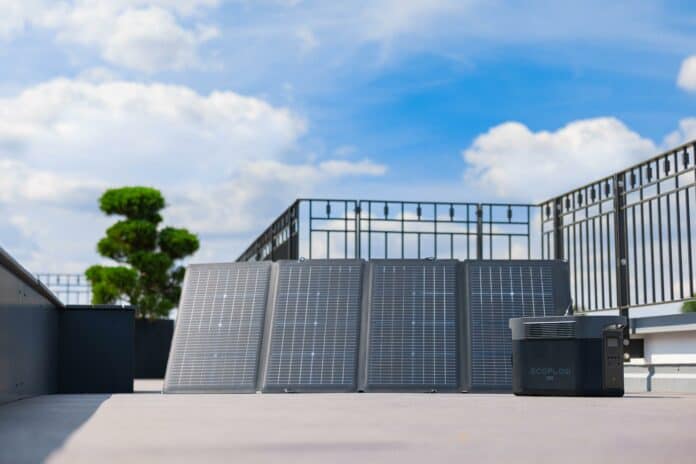Many factors determine the number of solar panels one home will need; it’s more complex than just measuring the square footage. The climate, sun exposure, house age, building materials, appliances, and the number of occupants all play into how much power a house consumes.
Let’s walk through the factors that impact the size solar array you need for a 2,000 sq ft home.
How Much Solar Power Does a 2,000 Sq Ft House Need?
First, you’ll need to calculate how much power your house uses, which you can do by looking at your electricity bill. Most power bills fluctuate from month to month, so it’s best to take the highest number — you’d rather have more power than not enough.
If you opt for a grid-tied solar power system, some utility companies allow you to sell excess power that you generate through an arrangement called net metering. If you’re using an off-grid solar power system, you can store any excess energy you gather in a portable power station or solar generator like the EcoFlow DELTA Pro. EcoFlow’s solar generators are portable, so you could also use energy generated and stored from your home solar panels to power a campsite or RV. You also have the option to generate energy on the go using portable solar panels.
Estimate Your Solar Power Consumption
Once you’ve calculated your home’s energy usage, you can estimate how much solar power you need to produce.
For this example, we’ll assume you have a 2,000-square-foot home that you want to power entirely with 400w (watt) solar panels. The average 2,000-square-foot house uses approximately 1,000 kWh (kilowatts-hour) of power per month, which breaks down to an average usage of 32 kWh per day.
The typical 400w panel can produce anywhere between 1.2 kWh and 3 kWh per day, depending on the hours of peak sun exposure. To be safe, we’ll use a median value of 2 kWh.
To estimate how many panels you need, divide your total daily energy consumption (32 kWh) by the median measurement of daily power production of one solar panel (2 kWh). Using these averages, we’d need 16 400w panels for the house to run entirely on solar energy.

Assessing Solar Panel Efficiency
Solar panels each have an efficiency rating, which is a percentage that tells you how much of the sun’s energy the panel can convert into electricity. Even small changes in efficiency rating are important, as they can significantly impact power production.
An efficiency rating of 20% is considered good; a rating of 22.4% would be top-of-the-line for a home setup. Monocrystalline solar panels like the high-efficiency 400w rigid solar panel from EcoFlow can achieve up to 23% efficiency.
Consider Environmental Factors
Environmental factors play a huge role in solar power generation — the most significant are temperature, humidity, and sun exposure.
When estimating the number of panels you need, it’s best to look back at a few years’ worth of data. Many weather reporting sites will have information on temperature and humidity records.
With peak sun exposure, getting an accurate estimate is trickier, depending on your location. If you’re living in the United States, this online tool should help.
It’s always good to have multiple ways of generating electricity, so you’ll never have to stress about losing power on a rainy day. Many renewable energy solutions now come with numerous charging methods for that reason. For example, the Power Kit by Ecoflow has four options: solar panels, car charging, Smart Generator (Dual Fuel), and a standard household power outlet.
Multiple charging options reduce the likelihood of running short on power due to environmental factors beyond your control.
How Does Installation Affect Solar Panel Energy Production?
Installation can significantly impact the amount of energy your solar panels will produce, namely, where the panels are placed and how they’re oriented. You want to position the panels to capture the most sunlight, keeping in mind that the sun’s position changes throughout the day and the year.
In cases where your property doesn’t allow you to optimize the location of fixed solar panels, it’s also worth considering portable solar panels. These don’t require permanent installation. You can place them on the ground using the included kickstand and change the orientation for maximum solar energy capture over the course of the day.
Final Thoughts
Many factors decide how many solar panels your home needs — every residence is different. Start by determining your desired electricity consumption level and consider the other factors mentioned above.
Systems like the Ecoflow Smart Home Ecosystem and Power Kits offer a variety of choices for residential solar power generation and storage options.
Take control of your home’s electricity supply today.
